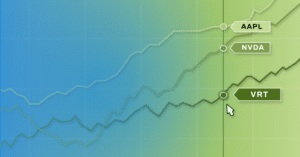You don’t have to pick individual stocks to generate enticing long-term returns. Many brokerage firms do the hard work for you by creating diversified exchange-traded funds, or ETFs. Fidelity is one of the best choices in the industry due to its low expense ratios and high annualized returns. While stocks don’t go up every single year, these funds capitalize on long-term uptrends within equities.
Investing in ETFs offers several benefits that you may not get from constructing your own portfolio. Cristian Mundy, a certified financial planner and senior wealth manager at Life Line Wealth Management, explains the advantages of ETFs like those that Fidelity offers. “Buying ETFs provides a high level of diversification, providing a broad range of asset exposure in specific sectors or indexes under a single investment. ETFs tend to have lower management fees and internal costs as compared to mutual funds, allowing for more compounded interest over time.”
Related: Sign up for stock news with our Invested newsletter.
ETFs are also beneficial for people who want to dip their toes in investing instead of committing a lot of capital right out of the gate.
“Typically, there are no minimums required to begin investing, making them easily accessible. ETFs trade through the trading day, therefore you can have a higher level of liquidity during market hours and transparency throughout,” Mundy explains.
Fidelity has offered ETFs since 2003 and now has dozens of them in a wide range of sectors and industries. You can find low-volatility ETFs that focus on fixed-income and high-yield dividend stocks. However, if you want to increase your returns, Fidelity’s growth ETFs offer exposure to companies that post impressive revenue and earnings growth.
Fidelity Blue Chip Growth ETF (FBCG)
The Fidelity Blue Chip Growth ETF gives investors exposure to more than 200 large growth stocks. The actively managed fund allocates at least 80% of its assets to blue-chip companies and is filled with tech giants.
The top five holdings are all Magnificent Seven stocks, with Nvidia Corp. (NVDA), Apple Inc. (AAPL) and Amazon.com Inc. (AMZN) making up about 34% of the fund’s total assets. The top-heavy fund has 62% of assets allocated to its top 10 holdings.
Blue-chip stocks can deliver respectable returns during bullish markets, but their proven business models are also more likely to withstand bearish markets. Companies like Apple and Amazon aren’t likely to go out of business during the next recession. Blue-chip stocks cater to investors who want to buy and hold for the long run without having much to worry about.
FBCG has a 0.59% net expense ratio and has delivered an annualized 10.2% total return over the past three years by net asset value. The fund has $2.9 billion in assets under management.
Low commission rates start at $0 for U.S. listed stocks & ETFs*. Margin loan rates from 4.83% to 5.83%.
Commission-free trading on stocks & ETFs. Earn $+0.06 per options contract and 5.1% APY on cash with no restrictions.
Invest in stocks, fractional shares, and crypto all in one place.
Fidelity Fundamental Large Cap Core ETF (FFLC)
The Fidelity Fundamental Large Cap Core ETF has a similar concept to that of Fidelity Blue Chip Growth ETF. Both Fidelity ETFs hold numerous large-cap stocks. However, FFLC isn’t as top-heavy, with its top 10 holdings making up 39% of the fund’s total assets.
FFLC has six Magnificent Seven stocks in its top 10 holdings. However, it also counts Exxon Mobil Corp. (XOM), Bank of America Corp. (BAC), Wells Fargo & Co. (WFC) and Broadcom Inc. (AVGO) among its largest positions. About 28% of the fund’s total assets are allocated across the information technology sector.
FFLC has about $700 million in total assets and a 0.38% expense ratio. The fund’s 0.9% 30-day SEC yield indicates that you’ll receive a modest regular distribution just for holding onto your shares. FFLC has achieved a solid annualized return of 16.9% over the past three years.
Fidelity Nasdaq Composite Index ETF (ONEQ)
The Fidelity Nasdaq Composite Index ETF is the fund that started it all. ONEQ was the first Fidelity ETF, and it’s been generating solid returns to this day. ONEQ has an annualized 17.7% return over the past five years and an annualized 16.3% return over the past decade.
ONEQ mirrors the Nasdaq Composite Index, with at least 80% of its assets in common stocks included in the index. Therefore, it’s not a surprise to see Magnificent Seven stocks dominating the list of equities. Apple, Microsoft Corp. (MSFT) and Nvidia each represent more than 10% of the fund’s total holdings, and about half of all assets are invested in the information technology sector, a higher percentage than the category average.
The Fidelity Nasdaq Composite Index ETF has a 0.21% expense ratio and a 0.4% 30-day SEC yield. It has $7.5 billion in assets. The Nasdaq has been a good benchmark to follow lately, outperforming the S&P 500 last year and over the past five years.
Fidelity Enhanced Large Cap Growth ETF (FELG)
The Fidelity Enhanced Large Cap Growth ETF has a 0.18% expense ratio and $3.1 billion in total assets. About 44% of the fund’s assets are allocated to the technology sector, with a strong emphasis on semiconductor and software stocks.
Roughly two-thirds of the fund’s assets are in mega-cap stocks, with the Magnificent Seven in the spotlight. Apple, Nvidia and Microsoft each make up more than 10% of the fund. This top-heavy ETF has allocated about 62% of its total capital to its top 10 holdings.
Pouring capital into Mag 7 stocks has worked out well for this Fidelity ETF and many other funds. FELG has an annualized 19.4% return over the past five years. The fund also has an impressive annualized return of 15.8% over the past 10 years.
Fidelity MSCI Information Technology Index ETF (FTEC)
The Fidelity MSCI Information Technology Index ETF aims to mirror the MSCI USA IMI Information Technology Index. FTEC has been a top-performing Fidelity ETF, with a 29.3% total return last year. Shares have also achieved an annualized return of 21.6% over the past five years and a stunning 20.5% average annual return over the past decade.
Unsurprisingly, you don’t have to look far into the top 10 holdings to find Magnificent Seven stocks. Apple, Nvidia and Microsoft make up roughly 45% of the fund’s total assets.
Broadcom, Salesforce Inc. (CRM), Oracle Corp. (ORCL), Cisco Systems Inc. (CSCO), Adobe Inc. (ADBE), Accenture PLC (ACN) and Advanced Micro Devices Inc. (AMD) round out the top 10 holdings, which make up 60% of the fund.
FTEC has a low 0.084% expense ratio and a 30-day SEC yield of 0.4%. It has $13 billion in total assets and dedicates nearly its entire portfolio to the information technology sector.
Fidelity High Dividend ETF (FDVV)
The Fidelity High Dividend ETF is a passively managed fund that aims to mirror the performance of the Fidelity High Dividend Index. Some dividend-paying Magnificent Seven stocks are in the fund’s top 10 holdings, but so are Procter & Gamble Co. (PG), Exxon Mobil and GE Aerospace (GE), differentiating the fund from other ETFs on this list.
FDVV has a 0.16% expense ratio and $4.3 billion in total assets. The fund has achieved an annualized 12.8% return over the past five years.
This fund is more spread out than most Fidelity ETFs. Only 32% of total assets are allocated to the top 10 positions, with no holding making up more than 7% of the fund’s total assets.
FDVV has 26% of its assets in the tech sector, with industrials (15%), consumer staples (12%) and energy (10%) also having a strong influence on fund returns.
Fidelity Disruptive Finance ETF (FDFF)
The Fidelity Disruptive Finance ETF is an actively managed fund that allocates at least 80% of its capital to disruptive finance companies. The fund has a 0.5% expense ratio and a 0.6% 30-day SEC yield.
FDFF’s shares have been volatile since the fund’s inception in spring 2020. That left the ETF with an annualized NAV return of 3.3% over the past three years. However, this ETF also soared by 27.8% in the last year.
Visa Inc. (V) is the largest equity position, making up 5.5% of the fund’s total assets. Apollo Global Management Inc. (APO), BlackRock Inc. (BLK) and Mastercard Inc. (MA) are the next-largest holdings. So it’s no surprise that the financials sector has heavy representation, making up 90% of the fund.
Should Investors Buy Multiple ETFs?
Some Fidelity ETFs deliver higher returns, but the possibility of higher returns also comes with more risk. Furthermore, you may want to invest in a Fidelity ETF that focuses on a single sector, but you may need additional ETFs for true diversification.
Mundy offers some suggestions and explains how owning multiple ETFs can be beneficial: “The simple answer is yes if it provides proper diversification among different sectors of the market. Owning multiple ETFs that invest in the same companies, sectors and assets won’t provide the solution. You must look under the hood of that ETF to make sure they complement one another. Investors must be mindful of over-diversification and redundancy to ensure you’re getting the most out of your investments.”

















